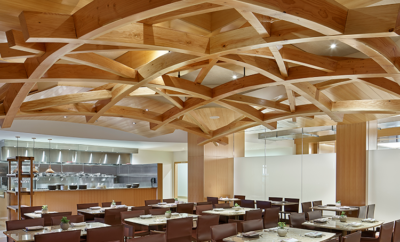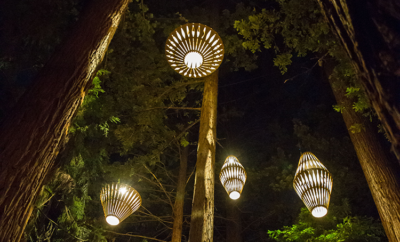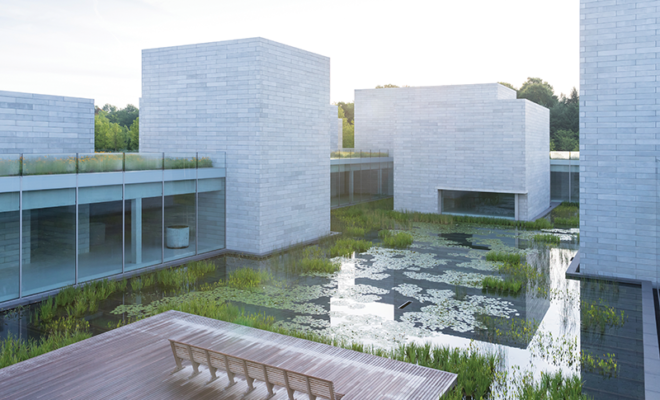 The water court at the center of Glenstone’s new Pavilions building serves as a serene resting place to reflect between visiting galleries. IWAN BAAN PHOTO. ALL ARTWORKS ILLUSTRATED ARE IN THE COLLECTION OF GLENSTONE FOUNDATION; ALL PHOTOS COURTESY OF GLENSTONE FOUNDATION.
The water court at the center of Glenstone’s new Pavilions building serves as a serene resting place to reflect between visiting galleries. IWAN BAAN PHOTO. ALL ARTWORKS ILLUSTRATED ARE IN THE COLLECTION OF GLENSTONE FOUNDATION; ALL PHOTOS COURTESY OF GLENSTONE FOUNDATION.
Architecture
Cultural Confluence
SINCE IT OPENED IN 2006, GLENSTONE has been a small private institution with a fine collection and a low profile. Not any longer. With the inauguration in October of a new building and expanded facilities on 230 acres in Potomac, Maryland (about fifteen miles northwest of Washington, DC), Glenstone has become a must-see destination for modern art enthusiasts, architecture aficionados, and landscape design lovers. Founders Mitchell and Emily Wei Rales and their collaborators set out to create a different type of museum, both aesthetically and experientially, and have succeeded on both counts.
The showpiece of the expansion is the Pavilions, a 204,000-square-foot, $200 million building designed by award-winning architect Thomas Phifer. Innovative in concept and meticulous in execution, the building is not immediately visible to visitors, who enter the site via the cedar-clad Arrivals Hall and are then directed outside for a ten-minute walk along a gently winding gravel path, as a cluster of gray-toned cubic forms seems to rise out of a grassy hill in the distance. The carefully choreographed approach merges architecture and landscape; Phifer speaks of “embedding the experience of nature into Glenstone.”
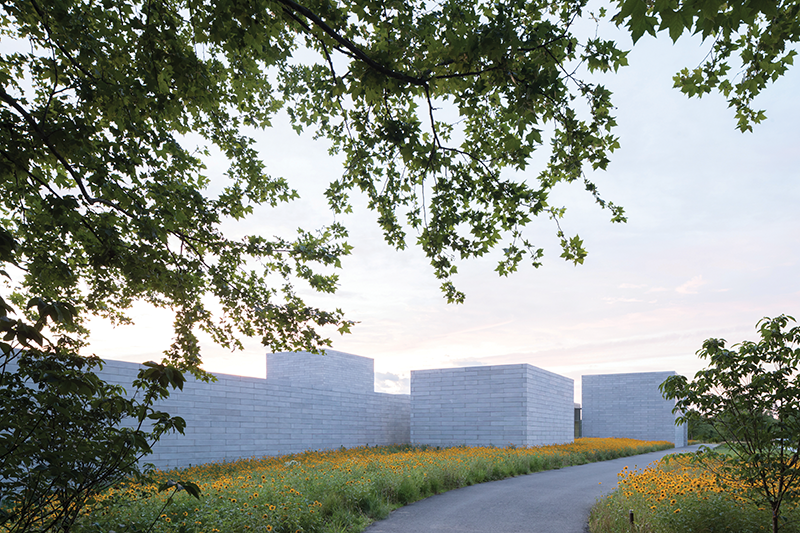
The approach to the Glenstone Pavilions. Iwan Baan photo.
Up close, the Pavilions materializes as a spare rectangular structure of horizontally stacked, one-by-six-foot concrete blocks surrounding a central water court, which is visible through glass walls as the visitor walks through the main corridor of the museum. Phifer has designed an environment considerate of the art and visitors by giving ample space to both. Referencing Jun’ichirō Tanizaki’s In Praise of Shadows, a theoretical treatise widely admired by architects, Phifer points out the transitions of light and shadow that break up the space visually. There are physical transitions as well: breathing space between galleries allows the visitor time to absorb what has just been seen before viewing what follows. The landscape is an essential part of the experience; most of the rooms are punctuated with windows, skylights, or clerestories. The effect is minimalist, but never stark.
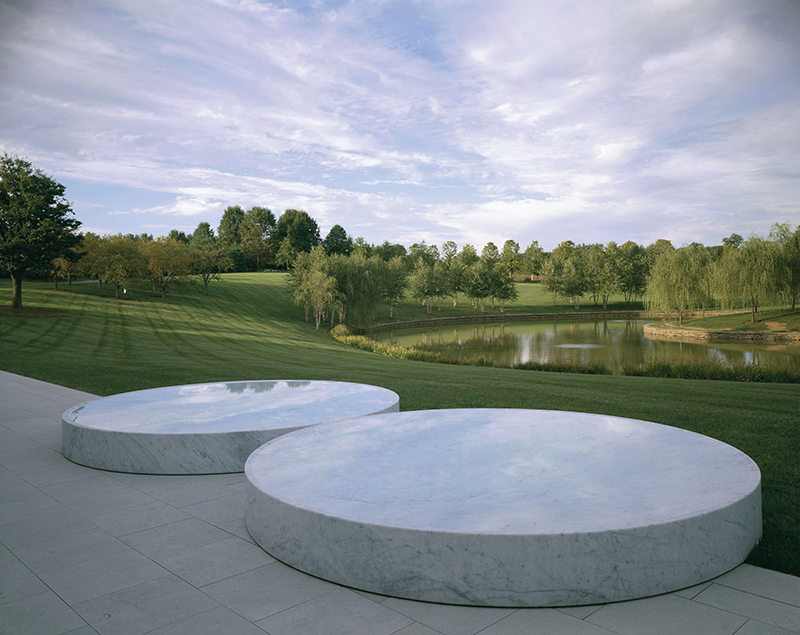
Installation of Untitled by Felix Gonzalez-Torres, 1992–1995.
Adam Greenspan of PWP Landscape Architecture, designers of the 9/11 Memorial in New York, has been involved in the project for the past fifteen years, subtly restructuring the bucolic site to look entirely natural, with carefully placed trees, rolling meadows, and streams, traversed by winding pebbled paths, accented with sculptures by Richard Serra, Ellsworth Kelly, and Jeff Koons, among others. In the Pavilions, artworks are displayed in ten galleries—each a different shape, size, and lighting configuration designed to fit the works it houses. The largest gallery, nine thousand square feet, is a series of airy connecting rooms that showcase sixty-five works by fifty-two artists. Made between 1943 and 1989, they represent styles from abstract expressionist to post-minimalist, and include marquee names like Calder, de Kooning, Rothko, and Rauschenberg as well as notable women artists including Agnes Martin, Linda Benglis, Lygia Pape, and Pipilotti Rist and less-celebrated but equally significant names like David Hammons and Alighiero e Boetti.
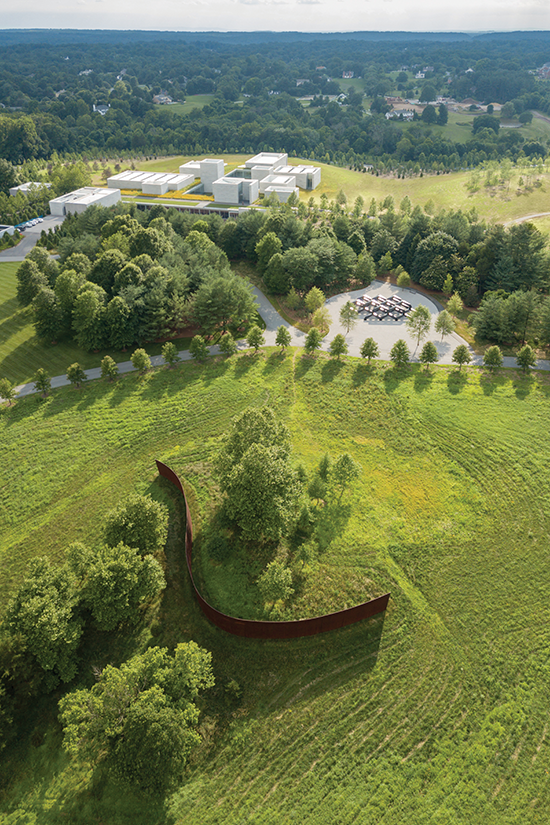
The Pavilions from above with Smith’s Smug and Contour 290 by Serra, 2004.
Most other galleries are solo installations, planned by Phifer in collaboration with the artist or the artist’s estate in order to best realize the artist’s vision. For On Kawara, he created a wood-floored, skylit room for three of his date paintings; and for Michael Heizer, a walled patio encloses a sixteen-foot-deep pit that holds a cluster of fifteen massive weathered-steel beams. Rather than being rotated for short-run shows, the installations will remain on display for extended periods, allowing visitors to experience the objects at different times of day and the landscape in different climates.
Every aspect of the visitor experience has been considered: there are no stanchions separating viewer and art, making everything feel accessible and encouraging interaction with the works. To avoid distractions, in place of explanatory wall texts, friendly and unintrusive gray-garbed guides are in each room to engage viewers in conversation about the art. Most are enrolled in Glenstone’s “emerging professionals” program that hires recent college graduates as full-time employees and prepares them for careers in the field.
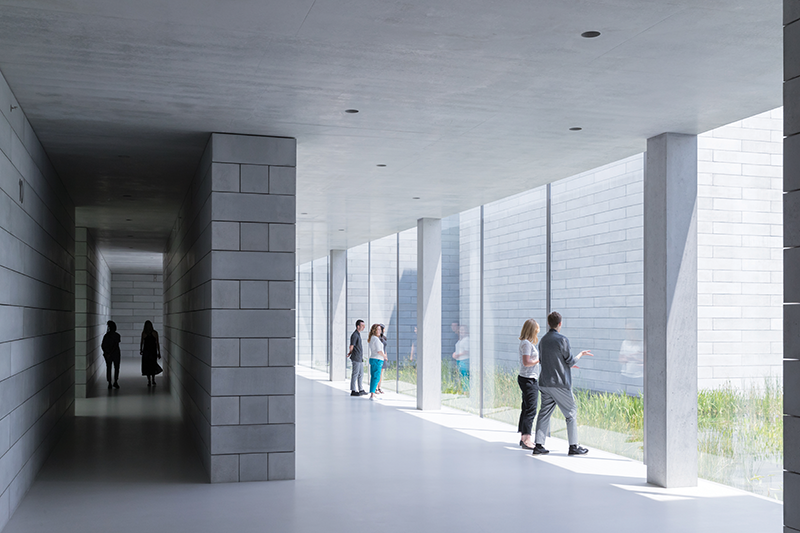
An interior passage at Glenstone. Iwan Baan photo.
Industrialist Mitchell Rales began collecting postwar art in the 1990s, and the collection now includes some thirteen hundred works spanning 150 years, with the goal of presenting “a global perspective of the most important art of our time,” according to museum director Emily Wei Rales, a former curator and gallery director who married Rales in 2008. They collect only established artists, seeking out risk-takers, Emily Rales says, “because those are the most interesting and challenging.” In planning the new facility, the Raleses visited about fifty museums around the world and cite as inspiration Denmark’s Louisiana Museum of Modern Art, the Menil Collection in Houston, and the Fondation Beyeler in Basel. The Pavilions shows only a small part of the Rales collection, which will form the basis of future exhibitions; Glenstone will lend art, but does not plan to borrow any.
The original Glenstone building, a thirty thousand-square-foot limestone structure by Charles Gwathmey, currently houses a Louise Bourgeois exhibition and will be used for future special exhibitions. The expanded facilities include two cafes, each in its own building, and a parking area. Admission is free, but reservations are required, with attendance limited to four hundred people per day, in order to allow for a more intimate experience.
Introducing the project, Mitchell Rales, Phifer, and Greenspan emphasized their collaboration, and the results attest to that. “Usually the museum comes first,” Rales commented, “here the art and the museum worked together.” The outcome is an approachable museum, where a visit is a leisurely respite from everyday life: inviting rather than intimidating, calming rather than frenetic, and an altogether satisfying experience. Other institutions would do well to take note.

The Gallery, Glenstone’s original exhibition building designed by architect Charles Gwathmey, stands against a backdrop of natural foliage, underscoring the architect’s interest in incorporating the landscape in his design. In the foreground is Untitled by Ellsworth Kelly, 2005, and beyond, Sylvester by Richard Serra, 2001.


